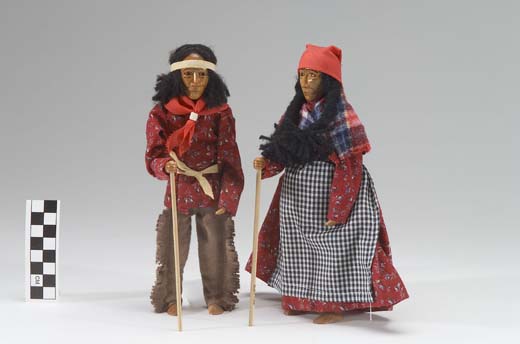Small Spirits: Gorgeously Crafted Dolls Are on View at New York City’s Heye Center
/https://tf-cmsv2-smithsonianmag-media.s3.amazonaws.com/filer/20110520110716Assiniboine-doll-265124_000.jpg)
Dolls are no longer just child's play. In the new exhibition "Small Spirits: Dolls at the National Museum of the American Indian" at the George Gustav Heye Center in New York City, visitors can see how different native communities created dolls and what those dolls say about their cultures. Featuring more than 90 dolls, dating from the 19th century through the present-day, this exhibit is both enjoyable and educational.
"Dolls are a really wonderful educational tool, within any particular cultural context," says Mary Jane Lenz, museum specialist for the National Museum of the American Indian. "Just as in any place in the world, doll play is a kind of way for children to learn values." Young American Indian girls learned some of those values, like patience and child-rearing, by caring for dolls. Similarly, they learned skills like sewing by making clothes for their dolls.
"Lots of times, girls were taught how to sew and how to tan hides and how to work the grasses and the porcupine quills by making clothes for their dolls," Lenz says, "because the expectation was that by the time they grew up and had families of their own, they’d be expected to make their families’ clothes, so that was great way to start."
Organized regionally, this hemispheric collection contains dolls from communities ranging from the arctic to Tierra del Fuego, the southernmost tip of South America. Dolls from the southwest tend to be made out of pottery and clay, while the dolls from the Plains are made and dressed in buffalo or elk hide, because those are the materials they had to work with. "A lot of the dolls of the east, like the Eastern Woodlands, are carved out of wood and dressed in trade cloth, which is something that they acquired very early with European contact," Lenz says. "And the dolls from the far west are dressed in, or made out of, grasses, which are very abundant in northern California, Oregon and Washington."
"Some of the dolls from South America are made from unusual material," Lenz says. "A Tapirape doll from Brazil is made from beeswax and tree pitch, while a set of tiny dolls dressed in scraps of cloth are actually the toe bones of a rhea, a large South American flightless bird similar to the ostrich."
The exhibition also boasts a tiny, wooden archaeological doll from the arctic, as well as a number of cradleboards, used by American Indian mothers to carry their babies around. "I think people will find it kind of interesting to see the various ways of wrapping up a baby and toting it around," Lenz says.
Other cultural cues are evident in some dolls' traditional dress, like: the "no-face" cornhusk doll of the Haudenosaunee (Iroquois) cultures, the brightly colored patchwork clothing of Seminole dolls, the elaborate regalia of Plains dolls and those dressed in 1930s Cherokee clothing made by Berdina and Richard G. Crowe (Eastern Band of Cherokee).
Featuring the work of noted artists, including: the mother and child carving by Makah carver Frank Allabush; Inupiaq dolls by Inupiaq artist Ethel Washington; and the storyteller figure, popularized by Helen Cordero (1915-1994), a potter from Cochiti Pueblo in New Mexico, this exhibition has something for everyone. "It's a huge generation-spanning kind of thing," Lenz says. "It's just one of those things that seems to have a universal appeal and a very strong educational component to it."
"Dolls are one of the things that are almost universal in human culture," says Lenz, "not only in the Americas, but throughout the world."
See the exhibit at the Smithsonian National Museum of the American Indian, Heye Center in New York City through February 19, 2012.
/https://tf-cmsv2-smithsonianmag-media.s3.amazonaws.com/accounts/headshot/Arcynta-Ali-240.jpg)

/https://tf-cmsv2-smithsonianmag-media.s3.amazonaws.com/accounts/headshot/Arcynta-Ali-240.jpg)